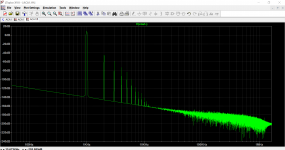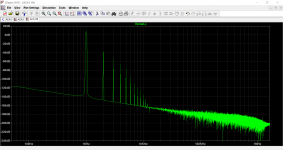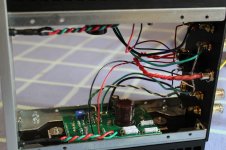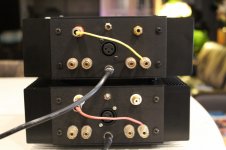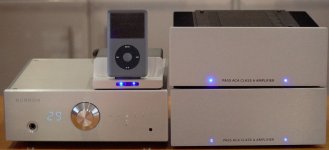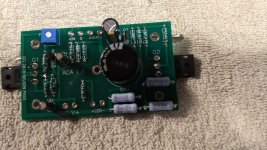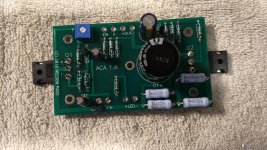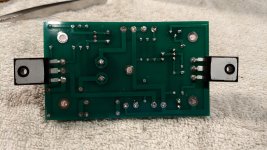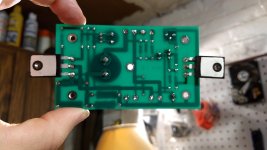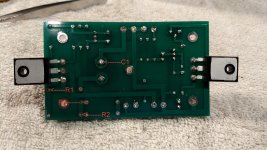varying them (too much) is not good idea from other reasons , not related to DC conditions of circuit
Oh! I guess my understanding is fuzzy here then, what's the issue? I do know that having variable gain doesn't work as discussed, but if the NFB loop is isolated, then what bit of the circuit gets out of whack when the gain is varied?
Is the volumen control princip well known in this pre-amp?
http://www.audio-gd.com/Pro/Headphoneamp/NFB1AMP/NFB1AMPEN.htm
It seems to be integrated in the design of the amp. They change a current in the output stage to control the gain. So the vol control is not before or after the preamp.....but somewhere in the middle?
I have for a long time considered trying their DAC...….read some positive reviews…..and the quality seems to be ok.....even that it is "made in China"....for the Preamp I will of course build a Pass DIY......starting with BA-3, then Korg…...BA3 is still ok even that a new one was presented at BAF 2018?
http://www.audio-gd.com/Pro/Headphoneamp/NFB1AMP/NFB1AMPEN.htm
It seems to be integrated in the design of the amp. They change a current in the output stage to control the gain. So the vol control is not before or after the preamp.....but somewhere in the middle?
I have for a long time considered trying their DAC...….read some positive reviews…..and the quality seems to be ok.....even that it is "made in China"....for the Preamp I will of course build a Pass DIY......starting with BA-3, then Korg…...BA3 is still ok even that a new one was presented at BAF 2018?
BA-3 is wonderful.
The new one is super interesting and will cost less to build, it was designed to use commonly available parts and get excellent performance as a preamp. I'm ordering parts right now for the prototype PCB that Wayne gave away at the show. Parts cost for the preamp circuit itself looks to be ~ $10/channel.
The new one is super interesting and will cost less to build, it was designed to use commonly available parts and get excellent performance as a preamp. I'm ordering parts right now for the prototype PCB that Wayne gave away at the show. Parts cost for the preamp circuit itself looks to be ~ $10/channel.
..... but if the NFB loop is isolated, then what bit of the circuit gets out of whack when the gain is varied?
for my untrained eye - nuttin' goes out of whack ...... except maybe some buzz if you approach OLG , in case of sloppy wiring
MEPER - If you vary the gain resistor you will also vary the operating points of the devices downstream, and you'd have to re-set the DC operating point (the 'bias') at any given gain/volume.
It's one of those ideas where it seems like it would work, believe me, I've asked the same question!!

The right answer is a preamp. Wayne Colburn presented a perfect solution at BAF on Sunday.
My two ACA's are completed and working quite well.
While I am by no means an electronics tech, I begin to understand at least one, maybe two, reasons why it is not advisable to build volume and/or balance control into them.
1. Adherence to the fundamental KISS principle.
2. Would limit/make difficult the flexibility of the ACA.
It's a beautiful thing that it can quite easily be connected for use in 4
different operational modes and work well in all 4, depending on
application.
Therefore, I have come to believe that a preamp is the way to go with the ACA's and am beginning to compile my list of requirements for one.
1. Some gain, preferably variable.
2. Overall volume and balance control.
3. 2 inputs minimum, shouldn't ever need more than 3.
4. If possible, add some quality to the signal that keeps my less well
recorded CD's from sounding like a$$ without hindering the CD's that are
actually well recorded.
Accordingly, the direction this thread has taken has my attention and I look forward to hearing what those more expert in this matter have to say.
Have you actually tried altering the feedback ratio ?
Increasing R12 will increase the input sensitivity, but whether you feel it is subjectively better or worse would have to be tried with extended listening. This shows the output at 1 watt/8 ohm for standard gain (39k2 for R12) and then with R12 at 150k. This gives a gain increase from 10.5db to almost 20db.
Increasing R12 will increase the input sensitivity, but whether you feel it is subjectively better or worse would have to be tried with extended listening. This shows the output at 1 watt/8 ohm for standard gain (39k2 for R12) and then with R12 at 150k. This gives a gain increase from 10.5db to almost 20db.
Attachments
Last edited:
I have not tried it......it was just an idea if if would be possible to integrate a vol control in the design. But can see you have tried it.....and it seems to work. The question is if a weak signal which needs high gain sounds good with less NFB and lower damping factor.....or a weak signal would sound better with more NFB and higher damping factor. It would be nice if a weak input signal like less NFB than a strong input signal......then this vol control would be a "win win"....but I don't know any technical reason why it should be so......just an imagination 
Oh! I guess my understanding is fuzzy here then, what's the issue? I do know that having variable gain doesn't work as discussed, but if the NFB loop is isolated, then what bit of the circuit gets out of whack when the gain is varied?
If too much nfb is applied the bandwidth increases too far. Due to phase issues at very high frequencies the nfb can change to positive feedback. Meltdown is imminent. Don't ask how I learned this.
JimT
I have not tried it......it was just an idea if if would be possible to integrate a vol control in the design. But can see you have tried it.....and it seems to work. The question is if a weak signal which needs high gain sounds good with less NFB and lower damping factor.....or a weak signal would sound better with more NFB and higher damping factor. It would be nice if a weak input signal like less NFB than a strong input signal......then this vol control would be a "win win"....but I don't know any technical reason why it should be so......just an imagination
Adding a variable control within the feedback loop isn't a great idea tbh, but increasing the basic gain is certainly worth trying imo and could obviate the need for an additional gain stage in front of the ACA.
As the gain is increased, so to is the noise contribution. Those with high sensitivity speakers would have to make a judgement call on whether it was acceptable or not. It may make no noticeable difference in practice.
I ended up with 33.1K and 121K as the two NFB resistors as I wanted a little higher input impedance so I could use passive preamp also. But I ended up using an active preamp. The values works well. I selected 0.1% resistors to have exact same gain in both channels. I have a little less gain than the standard ACA. Maybe good for driving the 15" woofers in my OB speakers......there seems to be good control even that it is a small amp.
My two ACA's are completed and working quite well.
While I am by no means an electronics tech, I begin to understand at least one, maybe two, reasons why it is not advisable to build volume and/or balance control into them.
1. Adherence to the fundamental KISS principle.
2. Would limit/make difficult the flexibility of the ACA.
It's a beautiful thing that it can quite easily be connected for use in 4
different operational modes and work well in all 4, depending on
application.
Therefore, I have come to believe that a preamp is the way to go with the ACA's and am beginning to compile my list of requirements for one.
1. Some gain, preferably variable.
2. Overall volume and balance control.
3. 2 inputs minimum, shouldn't ever need more than 3.
4. If possible, add some quality to the signal that keeps my less well
recorded CD's from sounding like a$$ without hindering the CD's that are
actually well recorded.
Accordingly, the direction this thread has taken has my attention and I look forward to hearing what those more expert in this matter have to say.
I'm also no expert on this but I can share my experience. When I built my first amp I included a volume control and if my skills had permitted it I would also have included a balance control and phono pre. I thought building an "integrated amp" was the way to go. Two years later I think it makes more sense to keep the pre and "power" amp separated - even if the pre has is a passive without gain. It allows for more flexibility down the line. These days i have 4 or 5 phono stages and I enjoy that they're not built into the amp so i can easily switch them around.
With regards to a preamp I can recommend the P88 by Rod Elliott. I've been experimenting with the design for a few weeks and have been able to learn a lot from it. There's a thread over in the Analog Line Level section if you're interested. It would meet most of your requirements: variable gain, volume and balance control, you can add as many inputs as you want. It will NOT change the sound of your CDs as it's an amp and not a mixing console
I build one using a breadboard (first time i did this) and it took me maybe an hour and 20 dollars in parts. worth a try. Of course you can also buy the PCB from Rod Elliott and the build will be even easier and quicker.
I'm also no expert on this but I can share my experience. When I built my first amp I included a volume control and if my skills had permitted it I would also have included a balance control and phono pre. I thought building an "integrated amp" was the way to go. Two years later I think it makes more sense to keep the pre and "power" amp separated - even if the pre has is a passive without gain. It allows for more flexibility down the line. These days i have 4 or 5 phono stages and I enjoy that they're not built into the amp so i can easily switch them around.
With regards to a preamp I can recommend the P88 by Rod Elliott. I've been experimenting with the design for a few weeks and have been able to learn a lot from it. There's a thread over in the Analog Line Level section if you're interested. It would meet most of your requirements: variable gain, volume and balance control, you can add as many inputs as you want. It will NOT change the sound of your CDs as it's an amp and not a mixing console
I build one using a breadboard (first time i did this) and it took me maybe an hour and 20 dollars in parts. worth a try. Of course you can also buy the PCB from Rod Elliott and the build will be even easier and quicker.
You have come to the same conclusion as I for similar reasons.
Don't want to change the sound so much as smooth off some rough edges, perhaps as adding a tube(s) into the signal path reportedly can do.
I understand that I may lose some of the delightful detail I'm hearing now from the well recorded CD's.
Maybe a pre with tube and discreet output sections is what I should be looking for.
Thank you for the recommendation, on my way to the Analog Line Level section to look into the Rob Elliot P88 now.
EDIT: Well, what do you know. I didn't recognize the name, but I read through his website extensively a few years ago while researching the viability of active crossovers.
Good call, I have much confidence in his "audio think".
Last edited:
ACA 1.5 and 1.6
Build of the 1.5 and 1.6 versions of the ACA Amp completed as bridged mono-blocks. Thank you to Nelson Pass for his generosity to the DIY community. Thank you also the the folks at DiyAudio and the skilled technical contributors who selflessly provide the build guides and post responses.
I connected the ACAs to my Burson Audio Conductor Virtuoso Headphone Amp which incorporates a DAC (SABRE 32 chip) and line stage pre-amp. Input source is an Ipod through Cambridge Audio doc. Speakers are Duntech DSM 15 which are a 2 way speaker with efficiency factor at 89dB SPL with nominal impedance of 4 ohms.
In my listening sessions i pumped every style of music genre into this system and was immediately impressed with the performance of the ACA amps. At no stage did the amps fail to supply ample, clean power to the source components. Astounding listening experience - pure and simple.
Build of the 1.5 and 1.6 versions of the ACA Amp completed as bridged mono-blocks. Thank you to Nelson Pass for his generosity to the DIY community. Thank you also the the folks at DiyAudio and the skilled technical contributors who selflessly provide the build guides and post responses.
I connected the ACAs to my Burson Audio Conductor Virtuoso Headphone Amp which incorporates a DAC (SABRE 32 chip) and line stage pre-amp. Input source is an Ipod through Cambridge Audio doc. Speakers are Duntech DSM 15 which are a 2 way speaker with efficiency factor at 89dB SPL with nominal impedance of 4 ohms.
In my listening sessions i pumped every style of music genre into this system and was immediately impressed with the performance of the ACA amps. At no stage did the amps fail to supply ample, clean power to the source components. Astounding listening experience - pure and simple.
Attachments
I need help. Just finished the 1.6 kit.
Left channel works fine. Right channel does not.
Both were biased to 12v.
Wiring was quintuple checked as ok.
Right heatsinks get hot just as the left do.
LED lights up on Right channel.
So, from what I can gather, there is power to the board and it goes where it should.
I checked the Voltage measurements with power on and they were spot on.
I checked resistance, and they were spot on, except some 1k readings were coming in at 1.5k.
This was the second of the two boards I stuffed and soldered, so it was a smoother and neater (don't judge my inability to get the resistors centered) process.
I can't figure out what is going on. Q3 or Q4 not working perhaps?
Please help.
Left channel works fine. Right channel does not.
Both were biased to 12v.
Wiring was quintuple checked as ok.
Right heatsinks get hot just as the left do.
LED lights up on Right channel.
So, from what I can gather, there is power to the board and it goes where it should.
I checked the Voltage measurements with power on and they were spot on.
I checked resistance, and they were spot on, except some 1k readings were coming in at 1.5k.
This was the second of the two boards I stuffed and soldered, so it was a smoother and neater (don't judge my inability to get the resistors centered) process.
I can't figure out what is going on. Q3 or Q4 not working perhaps?
Please help.
Attachments
If the DC conditions are correct (biases OK and runs hot) then the most likely cause is a problem with the input wiring, or less likely, no continuity to the speaker output.
If you hear the usual noises at power on and off via the speaker then the output wiring is OK.
Measure and test for continuity from the RCA input all the way to R11. Also make sure that the RCA doesn't read short circuit from inner to outer connections.
If you hear the usual noises at power on and off via the speaker then the output wiring is OK.
Measure and test for continuity from the RCA input all the way to R11. Also make sure that the RCA doesn't read short circuit from inner to outer connections.
I would start simple - on the non-working board, retouch / reflow all of the solder joints.
Then check wiring. Reassemble to chassis.
As Mooly also suggested, input shorts / output wiring continuity.
Then, with everything plugged in, check the voltages ala Step 56 of the build guide
Amp Camp Amp V1.6 Build Guide - diyAudio Guides
Then check wiring. Reassemble to chassis.
As Mooly also suggested, input shorts / output wiring continuity.
Then, with everything plugged in, check the voltages ala Step 56 of the build guide
Amp Camp Amp V1.6 Build Guide - diyAudio Guides
While I agree with the idea of 'starting simple', I would hardly say reflowing all solder joints qualifies as 'simple', when it can be an simple input cable issue.
I'd first do as Mooly suggests. After checking that, maybe start refilling stuff.
That's me though.
Best,
Rafa.
I'd first do as Mooly suggests. After checking that, maybe start refilling stuff.
That's me though.
Best,
Rafa.
thanks.
I figure a reflow isn't that big of a deal - I love to solder and it will take very little time with the board out.
I'll check the potential continuity issues first though.
I'll report back.
OH, no turn on noise for this channel.
If you measure the resistance across the input RCA socket, ring to inner part, it should be around 50k ohms (use the 2 meg range). The output terminals Red to Black should read around 1k ohms (on the 20k range). Wait a few seconds for the meter to 'climb'.
Looking at the picture, the top solder joint on the large capacitor (C1) and R1, R2 and R3 do not look good, but it might be a trick of the light. But touch them all up anyway.
Alan
Attachments
Last edited:
- Home
- Amplifiers
- Pass Labs
- Amp Camp Amp - ACA
